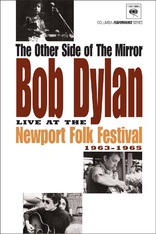The Other Side of the Mirror: Bob Dylan Blu-ray Movie
HomeThe Other Side of the Mirror: Bob Dylan Blu-ray Movie 
Live at The Newport Folk Festival 1963-1965Sony Music | 2007 | 87 min | Not rated | Apr 26, 2011
Movie rating
7 | / 10 |
Blu-ray rating
| Users | 4.0 | |
| Reviewer | 4.0 | |
| Overall | 4.0 |
Overview
The Other Side of the Mirror: Bob Dylan (2007)
Three legendary sets of performances by Bob Dylan at the Newport Folk Festival are captured by Academy Award winning director Murray Lerner.
Starring: Bob DylanDirector: Murray Lerner (I)
| Music | 100% |
Specifications
Video
Video codec: MPEG-4 AVC
Video resolution: 1080p
Aspect ratio: 1.33:1
Original aspect ratio: 1.37:1
Audio
English: LPCM 5.1 (48kHz, 24-bit)
English: LPCM 2.0 (48kHz, 24-bit)
English: Dolby Digital 5.1
Subtitles
English, French, German, Italian, Spanish
Discs
25GB Blu-ray Disc
Single disc (1 BD)
Playback
Region A (B, C untested)
Review
Rating summary
| Movie | 4.0 | |
| Video | 3.0 | |
| Audio | 4.5 | |
| Extras | 3.0 | |
| Overall | 4.0 |
The Other Side of the Mirror: Bob Dylan Blu-ray Movie Review
The times, they were a-changin'.
Reviewed by Jeffrey Kauffman April 24, 2011Why is it that some lovers of high definition Blu-rays can go absolutely ballistic if the latest movie release doesn't include a lossless audio option, and yet these same people think absolutely nothing about stuffing their iPods with thousands of songs in the heavily compressed MP3 format? Isn't it odd, if not outright sad, that music doesn't seem to matter that much to everyday consumers anymore? Of course music itself is not the same as how it's delivered to the listener, but the rise in popularity of lossy reproduction doesn't augur well for how people think about the music they're listening to. How times have changed, to paraphrase a certain folk music legend. In the halcyon days of Camelot and the Kennedys, the United States were awash in a new idealism and hopefulness, a sort of brashness that accompanied the vigor of a newly youthful Presidential administration, and that same sense of newness and energy permeated the arts as well. Rock and roll had given way, albeit fitfully, to a nascent folk movement as the Kennedys moved into the White House, that brought a new social and political consciousness to Top 40 music. Of course iconic songwriters like Woody Guthrie and Pete Seeger had been staking out this territory for decades. But suddenly music seemed to matter to listeners en masse in a way it hadn't for years, perhaps ever, and no one seemed to catch the tenor of those times better than Bob Dylan. It may have indeed been the era of another kind of lossy reproduction—the long playing vinyl record album—but few would argue that the music itself assumed paramount importance in fans’ minds.
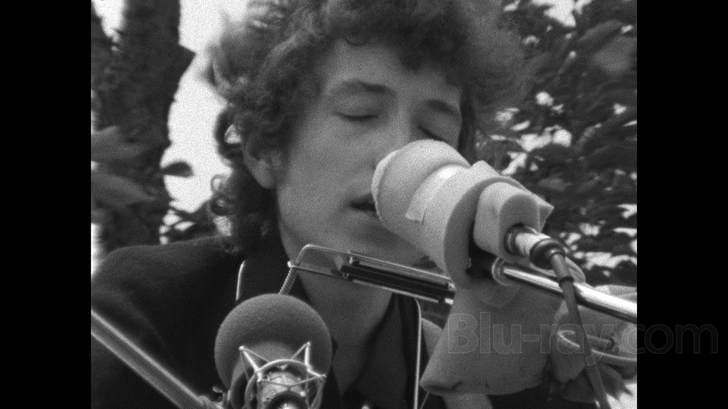
The Newport Folk Festival had itself been the symbol of a sea change in popular music, having been spun off of the previuosly existing Newport Jazz Festival in 1959. For at least a few years prior to Dylan’s ascendancy, then, it had been the bastion for mainstream folk artists, and when Dylan appeared there in 1963 and 1964, he was greeted as a conquering hero who had brought this audience's beloved music to the masses as no other artist of his generation. In fact in the 1964 concert, none other than Johnny Cash anointed Dylan as "the finest songwriter of the age." Other artists like Peter, Paul and Mary may have had bigger hits with Dylan's material than Dylan himself ever did, but there was no questioning who the fountainhead of creativity of this exciting new folk movement was.
But innovation and newness only go so far, as the 1965 concert captured on this historic set of concerts proves. Dylan had begun experimenting with amplified instruments and he decided to do part of his 1965 performance with electric guitars. That probably doesn't sound like much of a big deal to modern sensibilities, but it rocked (no pun intended) the folk community to its core in 1965 and led to one of the most hotly debated nights of live music that Newport had ever seen. It's all captured here in thrilling immediacy, and anyone who insists that the audience doesn't roundly "boo" Dylan after he finishes an electric version of "Maggie's Farm" need only watch this footage to see what really happened. Others insist the booing wasn't related to the use of electric instruments, which begs the question of why hapless emcee Peter Yarrow (of Peter, Paul and Mary), in begging Dylan to take the stage for an encore, attempts to calm the rowdy audience by saying Dylan is looking for an acoustic guitar.
The Other Side of the Mirror captures Dylan in his youthful prime. It also captures an artist undergoing signficant changes, both musically and personally, over a relatively short span of time. The 1963 concert finds Dylan almost embarrassingly earnest, with pinched eyebrows and an almost naive quality that seems to be saying, "We can change the world through music." 1964 finds an artist more aware of his stardom, seeming to laugh at some kind of inside joke as he duets with Joan Baez. And 1965 presents Dylan as iconoclast, a superstar with nothing to lose and, in a way, nothing to prove. He's going to do it his way, and the repercussions be damned.
Of course the world was changing, too, perhaps surprisingly more between the 1963 and 1964 concerts than between the latter two. In November 1963 President Kennedy was assassinated, seeming to put an immediate end to an idyllic time full of hope and the bravado of youth. But then just a few months later, there was hope and bravado in abundance as the Beatles spearheaded the so-called British Invasion in American pop music, and suddenly Dylan and his folk co-horts seemed like yesterday’s news. It’s interesting to see Dylan’s sensibilities changed as a result of these epochal events, as he suddenly becomes just as interested in the medium as in the message. The Other Side of the Mirror captures Dylan in a considerably less self-aware light than the simultaneously released Don’t Look Back. Bold, fresh, perhaps even a bit arrogant, but nonetheless vital and in tune, both literally and figuratively, with his equally ardent audience, this is an exciting set of performances that shows what a galvanizing force Dylan was as folk music dared to plug itself in and challenge the Brits for pop chart dominance.
The performances included on this Blu-ray are:
1963
North Country Blues
With God On Our Side
Talkin’ World War III Blues
Who Killed Davey Moore?
Only a Pawn in Their Game
Blowin’ in the Wind
1964
Mr. Tambourine Man
It Ain’t Me, Babe
With God On Our Side
Chimes of Freedom
1965
All I Really Want to Do
If You Gotta Go, Go Now
Love Minus Zero/No Limit
Maggie’s Farm (electric)
Like a Rolling Stone (electric)
Mr. Tambourine Man
It’s All Over Now, Baby Blue
The Other Side of the Mirror: Bob Dylan Blu-ray Movie, Video Quality 
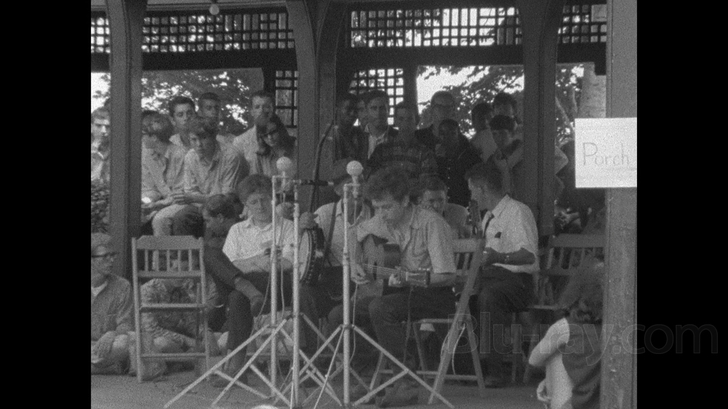
The Other Side of the Mirror: Bob Dylan Live at the Newport Folk Festival 1963-1965 arrives on Blu-ray with an AVC encoded 1080p image in 1.33:1. These live performances were shot on 16mm in less than ideal circumstances, so anyone expecting high definition wonderment with this release is in for a letdown. There is certainly an uptick in sharpness and detail from the 2007 DVD release, but is it earth shattering? Probably not to most eyes. Contrast still fluctuates widely, there are extremely milky blacks at times, and grain is at digital noise levels in several of the darker nighttime segments ("It's All Over Now, Baby Blue" probably being the worst example). There appears to have been no restoration done for this release, and there are the same blemishes which marred the previous home video release.
The Other Side of the Mirror: Bob Dylan Blu-ray Movie, Audio Quality 
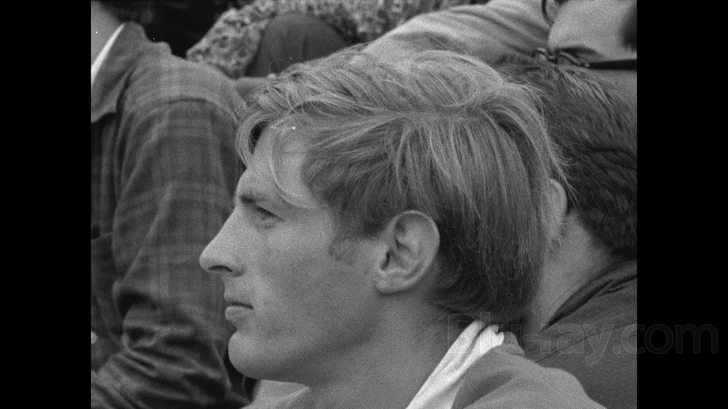
Sony Music, releasing The Other Side of the Mirror under its US Columbia label, does a fine job offering two lossless tracks on this release, an LPCM 5.1 (48kHz/24-bit) and an LPCM 2.0 (48kHz/24-bit), as well as a standard Dolby Digital 5.1 mix (which sounds surprisingly good). The lossless tracks are fantastic in and of themselves, but the source stems are obviously old and were recorded live, meaning there are fluctuating amplitude levels as well as occasional mix problems. There's no damage of any import per se to report, but even a lossless reproduction here can't completely erase the fact that these recordings are sometimes distorted, often lacking really robust low end, and other vagaries of having been recorded outside (1965's performance looks especially windy, which may have added to the recording woes). On the whole though, these sound amazing spry for their age and will certainly be loved by any Dylan fan.
The Other Side of the Mirror: Bob Dylan Blu-ray Movie, Special Features and Extras 
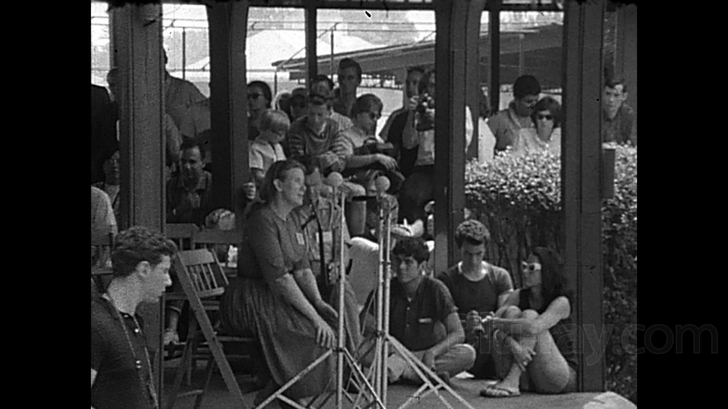
An Interview with Director Murray Lerner (HD; 25:42) finds the documentary's helmsman an incredibly articulate, thoughtful gentleman who mentions Eisenstein, T.S. Eliot and Dylan in virtually the same breath. Some more cynical types may not exactly go for his postulation that he's utilizing Eisensteinian montage/editing theory in The Other Side of the Mirror, but it's kind of interesting to hear him state that he thinks he is. He actually spends as much time talking about his personal background as he does about this particular project, but he's a fascinating man and this interview is well worth your time.
The Other Side of the Mirror: Bob Dylan Blu-ray Movie, Overall Score and Recommendation 
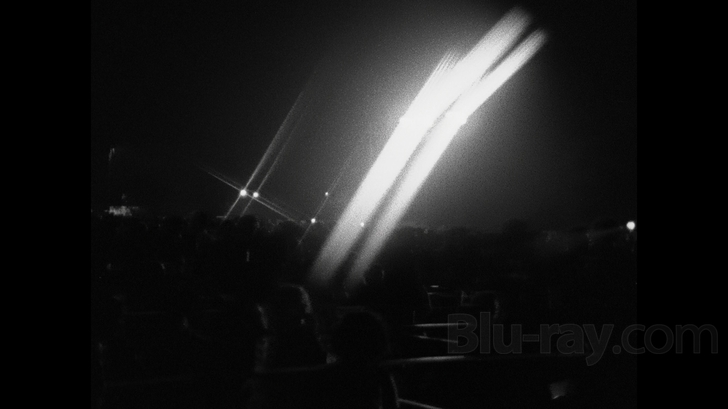
The three years captured on The Other Side of the Mirror: Bob Dylan Live at the Newport Folk Festival 1963-1965 were three of the most eventful years not just in American pop music history, but for the nation as a whole. The growing social consciousness which had been part and parcel of the folk movement's ascendancy as the 1950s turned to the 1960s had erupted into political foment that probably caught even its most ardent supporters by surprise. The change that Bob Dylan had sung was "blowin' in the wind" became a hurricane seemingly overnight somewhere in the mid-1960s, and Dylan himself was in the eye of the storm, at least insofar as his infamous 1965 electrified performance goes. This wonderful set of performances captures Dylan, as well as a host of other luminaries like Joan Baez, Judy Collins, Doc Watson, and Peter, Paul and Mary. Director Lerner just plops his camera down and lets the footage do the talking, and the results are phenomenal. While there's not really that much of an image upgrade on this Blu-ray, the lossless soundtracks sound excellent most of the time, and this release is Highly recommended.
Similar titles
Similar titles you might also like

The Beatles: Let It Be
Super Deluxe Edition | Blu-ray Audio
1970

Ziggy Stardust and the Spiders from Mars: The Motion Picture
50th Anniversary Edition
1979

The Doors: R-Evolution
2013

Kraftwerk: 3-D The Catalogue
Abridged
2017

Elvis Presley
Elvis: '68 Comeback Special - 50th Anniversary Edition
1968

Pink Floyd: Pulse
1995

The Big T.N.T. Show
1966

The Beatles: Sgt. Pepper's Lonely Hearts Club Band
Super Deluxe Edition | Blu-ray Audio
1967

The T.A.M.I. Show
1964

Jimi Hendrix: Jimi Plays Berkeley
1970

Rock & Roll Hall of Fame: In Concert: Encore
2010-2013

The Rolling Stones: From the Vault - Hampton Coliseum - Live in 1981
1981

Bob Dylan: 30th Anniversary Concert Celebration
1992

The Rolling Stones: Some Girls Live in Texas 1978
Special Edition
1978

Rush: Time Machine, Live in Cleveland
2011

The Doors: Live at the Isle of Wight Festival 1970
1970

Mötley Crüe: The End - Live in Los Angeles 4K
2016

Foo Fighters: Sonic Highways
2014

Joe Satriani: Satchurated, Live in Montreal 3D
2012

The Beatles
Blu-ray Audio | Limited 50th Anniversary Super Deluxe Edition | The White Album
1968
